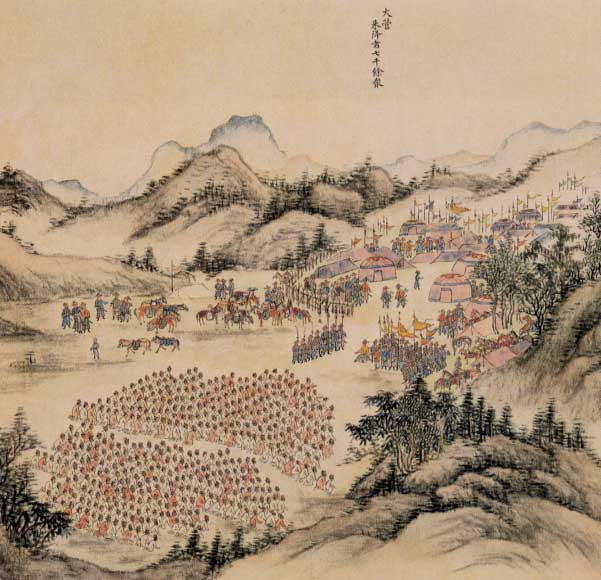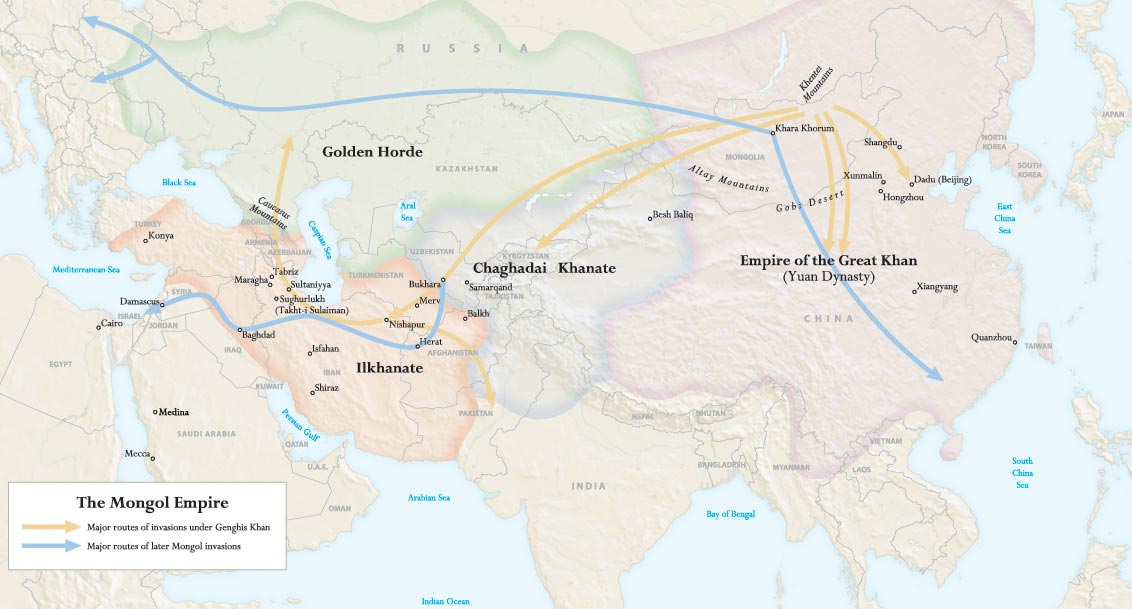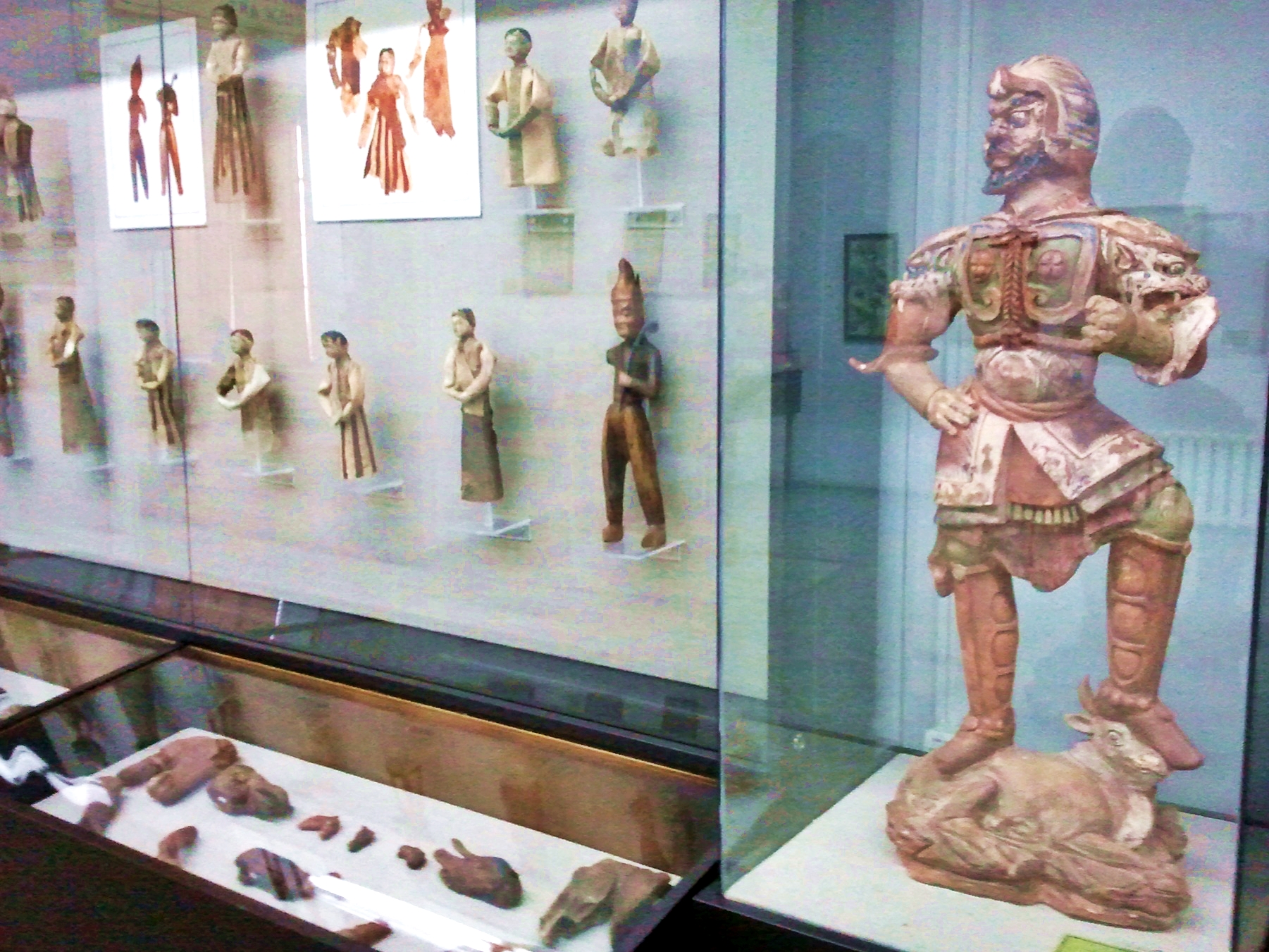|
Dzungar–Qing Wars
The Dzungar–Qing Wars ( mn, Зүүнгар-Чин улсын дайн, ) were a decades-long series of conflicts that pitted the Dzungar Khanate against the Qing dynasty and its Mongol vassals. Fighting took place over a wide swath of Inner Asia, from present-day central and eastern Mongolia to Tibet, Qinghai, and Xinjiang regions of present-day China. Qing victories ultimately led to the incorporation of Outer Mongolia, Tibet and Xinjiang into the Qing Empire that was to last until the fall of the dynasty in 1911–1912, and the genocide of much of the Dzungar population in the conquered areas. Background After the collapse of the Yuan dynasty in 1368, China's Mongol rulers withdrew to Mongolia and became known as the Northern Yuan dynasty. Over time, the Mongol state disintegrated into a series of Khanates, ruled by various descendants of Genghis Khan. The Qing dynasty defeated the Inner Chahar Mongol leader Ligdan Khan and annexed Inner Mongolia. While the Eastern ... [...More Info...] [...Related Items...] OR: [Wikipedia] [Google] [Baidu] |
Pacification Of The Dzungars
Pacification may refer to: The restoration of peace through a declaration or peace treaty: *Pacification of Ghent, an alliance of several provinces of the Netherlands signed on November 8, 1576 * Treaty of Berwick (1639), or ''Pacification of Berwick'', signed on June 18, 1639 between England and Scotland * Pacification sejm, one of several sessions of the Sejm, especially the one in 1736 concluding the civil war in the Polish–Lithuanian Commonwealth *Pacification of 1917, between religious and secular sects in the Netherlands A military or police action: * Pacification of Algeria (1835-1903), French military operations which aimed to put an end to various tribal rebellions *Occupation of Araucanía (1861–1883), also ''Pacification of the Araucanía'', the actions which led to the incorporation of Araucanía into Chile * Pacification of Ukrainians in Eastern Galicia (1930), a punitive action of Polish police against the Ukrainian minority in Poland *Pacification of Manchukuo, a ... [...More Info...] [...Related Items...] OR: [Wikipedia] [Google] [Baidu] |
Yue Zhongqi
Yue Zhongqi (岳鍾琪, 1686 – 1754) was a Chinese military commander of the Qing dynasty. He was a descendant of Yue Fei, and served as Ministry of War and Viceroy of Chuan-Shaan during the reign of the Yongzheng Emperor. Yue succeeded Nian Gengyao as Viceroy of Chuan-Shaan from 1725 to 1732. Zeng Jing, a ''xiucai'' in Hunan, sent his student Zhang Xi (張熙) to Xi'an in 1728, attempted to incite Yue to organize a plot to overthrow the Manchu-led Qing dynasty. Yue refused him and exposed his plot. Yue was commended by Yongzheng Emperor; Zeng Jing was easily caught and transported to Beijing. Qing Han Chinese general Yue Zhongqi interviewed the Tibetan collaborator with the Qing, Polhané Sönam Topgyé (P'o-lha-nas), concerning his involvement in crushing the Tibetan rebels, and sent a report to the Qing Yongzheng emperor on 17 August 1728. Yue also participated in the Dzungar–Qing Wars. He conquered Tibet and seized Lhasa with the 2,000 Green Standard soldiers a ... [...More Info...] [...Related Items...] OR: [Wikipedia] [Google] [Baidu] |
Northern Yuan Dynasty
The Northern Yuan () was a dynastic regime ruled by the Mongol Borjigin clan based in the Mongolian Plateau. It existed as a rump state after the collapse of the Yuan dynasty in 1368 and lasted until its conquest by the Jurchen-led Later Jin dynasty in 1635. The Northern Yuan dynasty began with the retreat of the Yuan imperial court led by Toghon Temür (Emperor Huizong of Yuan) to the Mongolian steppe. Although Yuan authority in most of China proper collapsed by 1368, Yuan loyalists in Yunnan led by Basalawarmi survived until their defeat by the Ming in 1382. This period featured factional struggles and the often only nominal role of the Great Khan. Dayan Khan and Mandukhai Khatun reunited the Mongol tribes in the 15th century. However, the former's distribution of his empire among his sons and relatives as fiefs caused the decentralization of the imperial rule. Despite this decentralization, a remarkable concord continued within the Dayan Khanid aristocracy, an ... [...More Info...] [...Related Items...] OR: [Wikipedia] [Google] [Baidu] |
Mongol
The Mongols ( mn, Монголчууд, , , ; ; russian: Монголы) are an East Asian ethnic group native to Mongolia, Inner Mongolia in China and the Buryatia Republic of the Russian Federation. The Mongols are the principal member of the large family of Mongolic peoples. The Oirats in Western Mongolia as well as the Buryats and Kalmyks of Russia are classified either as distinct ethno-linguistic groups or subgroups of Mongols. The Mongols are bound together by a common heritage and ethnic identity. Their indigenous dialects are collectively known as the Mongolian language. The ancestors of the modern-day Mongols are referred to as Proto-Mongols. Definition Broadly defined, the term includes the Mongols proper (also known as the Khalkha Mongols), Buryats, Oirats, the Kalmyk people and the Southern Mongols. The latter comprises the Abaga Mongols, Abaganar, Aohans, Baarins, Chahars, Eastern Dorbets, Gorlos Mongols, Jalaids, Jaruud, Kharchins, Khishigt ... [...More Info...] [...Related Items...] OR: [Wikipedia] [Google] [Baidu] |
China
China, officially the People's Republic of China (PRC), is a country in East Asia. It is the world's List of countries and dependencies by population, most populous country, with a Population of China, population exceeding 1.4 billion, slightly ahead of India. China spans the equivalent of five time zones and Borders of China, borders fourteen countries by land, the List of countries and territories by land borders, most of any country in the world, tied with Russia. Covering an area of approximately , it is the world's third List of countries and dependencies by area, largest country by total land area. The country consists of 22 provinces of China, provinces, five autonomous regions of China, autonomous regions, four direct-administered municipalities of China, municipalities, and two special administrative regions of China, Special Administrative Regions (Hong Kong and Macau). The national capital is Beijing, and the List of cities in China by population, most populous cit ... [...More Info...] [...Related Items...] OR: [Wikipedia] [Google] [Baidu] |
Yuan Dynasty
The Yuan dynasty (), officially the Great Yuan (; xng, , , literally "Great Yuan State"), was a Mongols, Mongol-led Dynasties in Chinese history, imperial dynasty of China and a successor state to the Mongol Empire after Division of the Mongol Empire, its division. It was established by Kublai Khan, Kublai, the fifth khagan-emperor of the Mongol Empire from the Borjigin clan, and lasted from 1271 to 1368. In orthodox Chinese historiography, the Yuan dynasty followed the Song dynasty and preceded the Ming dynasty. Although Genghis Khan had been enthroned with the Han Chinese, Han-style title of Emperor of China, Emperor in 1206 and the Mongol Empire had ruled territories including modern-day Northern and southern China, northern China for decades, it was not until 1271 that Kublai Khan officially proclaimed the dynasty in the traditional Han style, and the conquest was not complete until 1279 when the Southern Song dynasty was defeated in the Battle of Yamen. His realm was, ... [...More Info...] [...Related Items...] OR: [Wikipedia] [Google] [Baidu] |
Mongolia In 1636
Mongolia; Mongolian script: , , ; lit. "Mongol Nation" or "State of Mongolia" () is a landlocked country in East Asia, bordered by Russia to the north and China to the south. It covers an area of , with a population of just 3.3 million, making it the world's most sparsely populated sovereign nation. Mongolia is the world's largest landlocked country that does not border a closed sea, and much of its area is covered by grassy steppe, with mountains to the north and west and the Gobi Desert to the south. Ulaanbaatar, the capital and largest city, is home to roughly half of the country's population. The territory of modern-day Mongolia has been ruled by various nomadic empires, including the Xiongnu, the Xianbei, the Rouran, the First Turkic Khaganate, and others. In 1206, Genghis Khan founded the Mongol Empire, which became the largest contiguous land empire in history. His grandson Kublai Khan conquered China proper and established the Yuan dynasty. After the collapse of ... [...More Info...] [...Related Items...] OR: [Wikipedia] [Google] [Baidu] |
Dzungar Genocide
The Dzungar genocide () was the mass extermination of the Mongol Dzungar people by the Qing dynasty. The Qianlong Emperor ordered the genocide due to the rebellion in 1755 by Dzungar leader Amursana against Qing rule, after the dynasty first conquered the Dzungar Khanate with Amursana's support. The genocide was perpetrated by Manchu generals of the Qing army supported by Turkic oasis dwellers (now known as Uyghurs) who rebelled against Dzungar rule. The Dzungar Khanate was a confederation of several Tibetan Buddhist Oirat Mongol tribes that emerged in the early 17th century, and the last great nomadic empire in Asia. Some scholars estimate that about 80% of the Dzungar population, or around 500,000 to 800,000 people, were killed by a combination of warfare and disease during or after the Qing conquest in 1755–1757. After wiping out the native population of Dzungaria, the Qing government then resettled Han, Hui, Uyghur, and Sibe people on state farms in Dzungaria along w ... [...More Info...] [...Related Items...] OR: [Wikipedia] [Google] [Baidu] |
1911 Revolution
The 1911 Revolution, also known as the Xinhai Revolution or Hsinhai Revolution, ended China's last Dynasties in Chinese history, imperial dynasty, the Manchu people, Manchu-led Qing dynasty, and led to the establishment of the Republic of China (1912–1949), Republic of China. The revolution was the culmination of a decade of agitation, revolts, and uprisings. Its success marked the collapse of the Monarchy of China, Chinese monarchy, the end of 2,132 years of imperial rule in China and 276 years of the Qing dynasty, and the beginning of China's History of the Republic of China#Early republic (1912–16), early republican era.Li, Xiaobing. [2007] (2007). ''A History of the Modern Chinese Army''. University Press of Kentucky. , . pp. 13, 26–27. The Qing dynasty had struggled for a long time to reform the government and resist foreign aggression, but the Late Qing reforms, program of reforms after 1900 was opposed by conservatives in the Qing court as too radical and by refor ... [...More Info...] [...Related Items...] OR: [Wikipedia] [Google] [Baidu] |
Mongolia
Mongolia; Mongolian script: , , ; lit. "Mongol Nation" or "State of Mongolia" () is a landlocked country in East Asia, bordered by Russia to the north and China to the south. It covers an area of , with a population of just 3.3 million, making it the world's most sparsely populated sovereign nation. Mongolia is the world's largest landlocked country that does not border a closed sea, and much of its area is covered by grassy steppe, with mountains to the north and west and the Gobi Desert to the south. Ulaanbaatar, the capital and largest city, is home to roughly half of the country's population. The territory of modern-day Mongolia has been ruled by various nomadic empires, including the Xiongnu, the Xianbei, the Rouran, the First Turkic Khaganate, and others. In 1206, Genghis Khan founded the Mongol Empire, which became the largest contiguous land empire in history. His grandson Kublai Khan conquered China proper and established the Yuan dynasty. After the c ... [...More Info...] [...Related Items...] OR: [Wikipedia] [Google] [Baidu] |
Inner Asia
Inner Asia refers to the northern and landlocked regions spanning North, Central and East Asia. It includes parts of western and northeast China, as well as southern Siberia. The area overlaps with some definitions of 'Central Asia', mostly the historical ones, but certain regions that are often included in Inner Asia, such as Manchuria, are not a part of Central Asia by any of its definitions. Inner Asia may be regarded as the western and northern "frontier" of China proper of the former Qin dynasty and as being bounded by East Asia proper, which consists of China, Japan and Korea. The extent of Inner Asia has been understood differently in different periods. "Inner Asia" is sometimes contrasted to "China Proper", that is, the original provinces, those with majority Han Chinese populations. In 1800, Inner Asia consisted of four main areas, namely Manchuria (modern Northeast China and Outer Manchuria), Mongolia ( Inner and Outer), Xinjiang ( East Turkestan), and Tibet. These ... [...More Info...] [...Related Items...] OR: [Wikipedia] [Google] [Baidu] |
Agui
Agui (; ; September 7, 1717 – October 10, 1797) was a Manchu noble general for the Qing dynasty. As the only son of Akdun, he was a scion of a noble family who led a number of important Manchu military operations, including several of the "Ten Great Campaigns". Sino-Burmese War On April14, 1768, Fuheng was appointed military commissioner (Jinglue) and Agui and Aligun, both Manchus, were appointed deputies. This occurred due to the death of the previous commander Ming Rui. Agui had already proven himself in Chinese Turkestan, as a competent commander. He served under Fuheng in the 1769 failed campaign of the Sino-Burmese War (1765–1769). Agui soon found himself out of favor as he was not fully supportive of Fuheng's plans and the Chinese Qianlong Emperor was vocal of his dislike for this behavior. The main push occurs in December at the height of the disease period and the Chinese suffer great losses to disease. Confusion surrounds the following events. Some sources say that ... [...More Info...] [...Related Items...] OR: [Wikipedia] [Google] [Baidu] |





